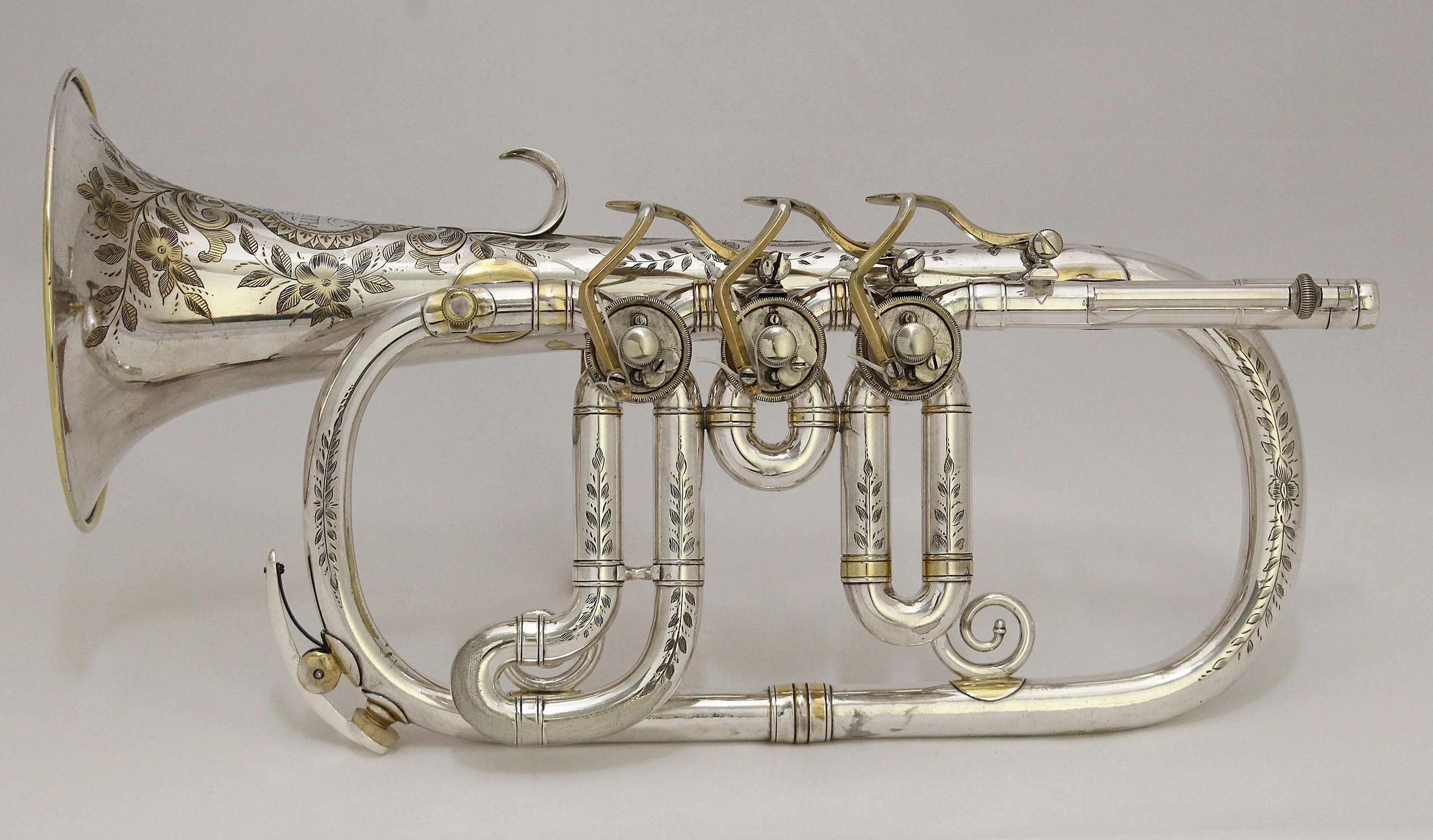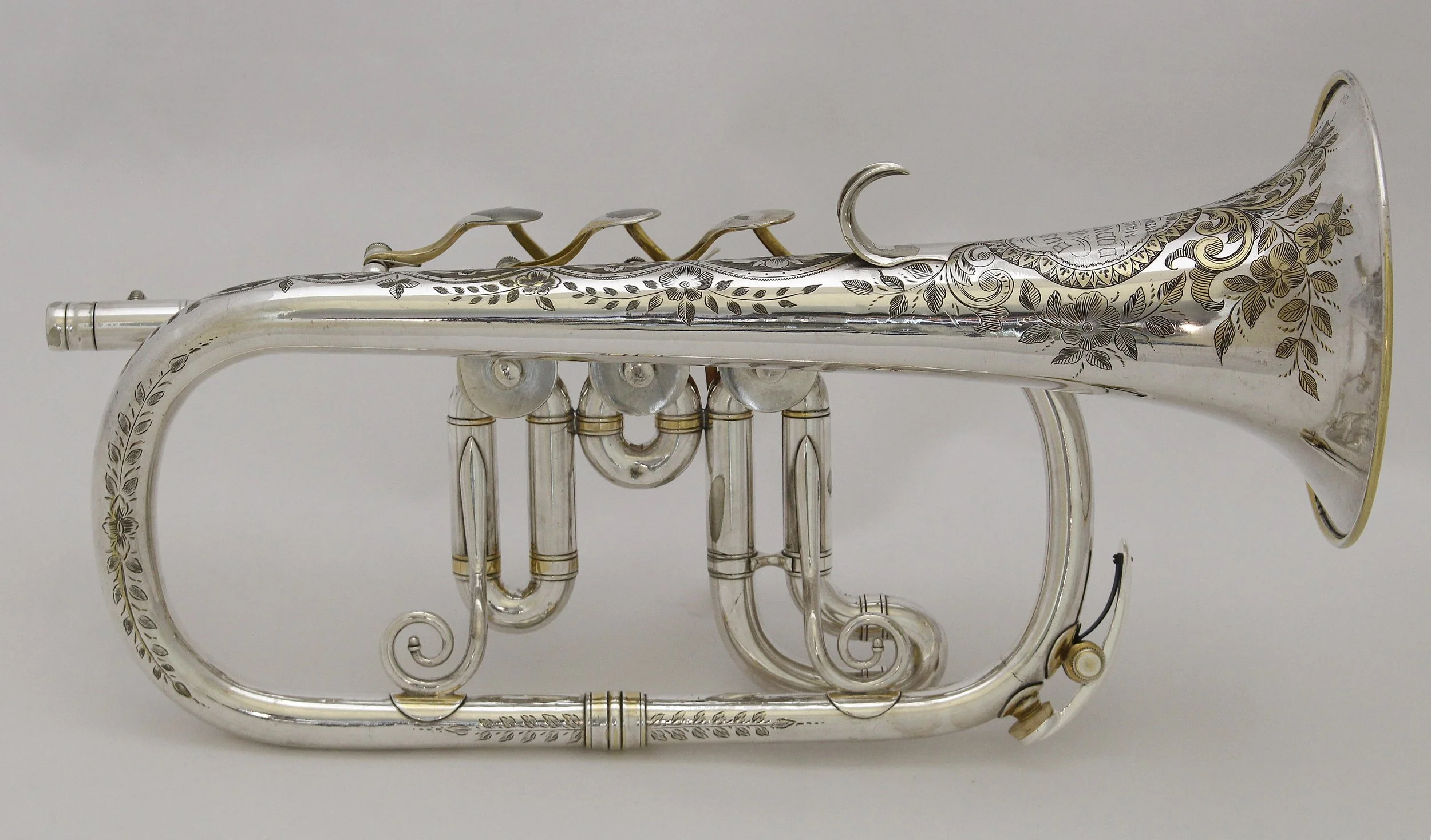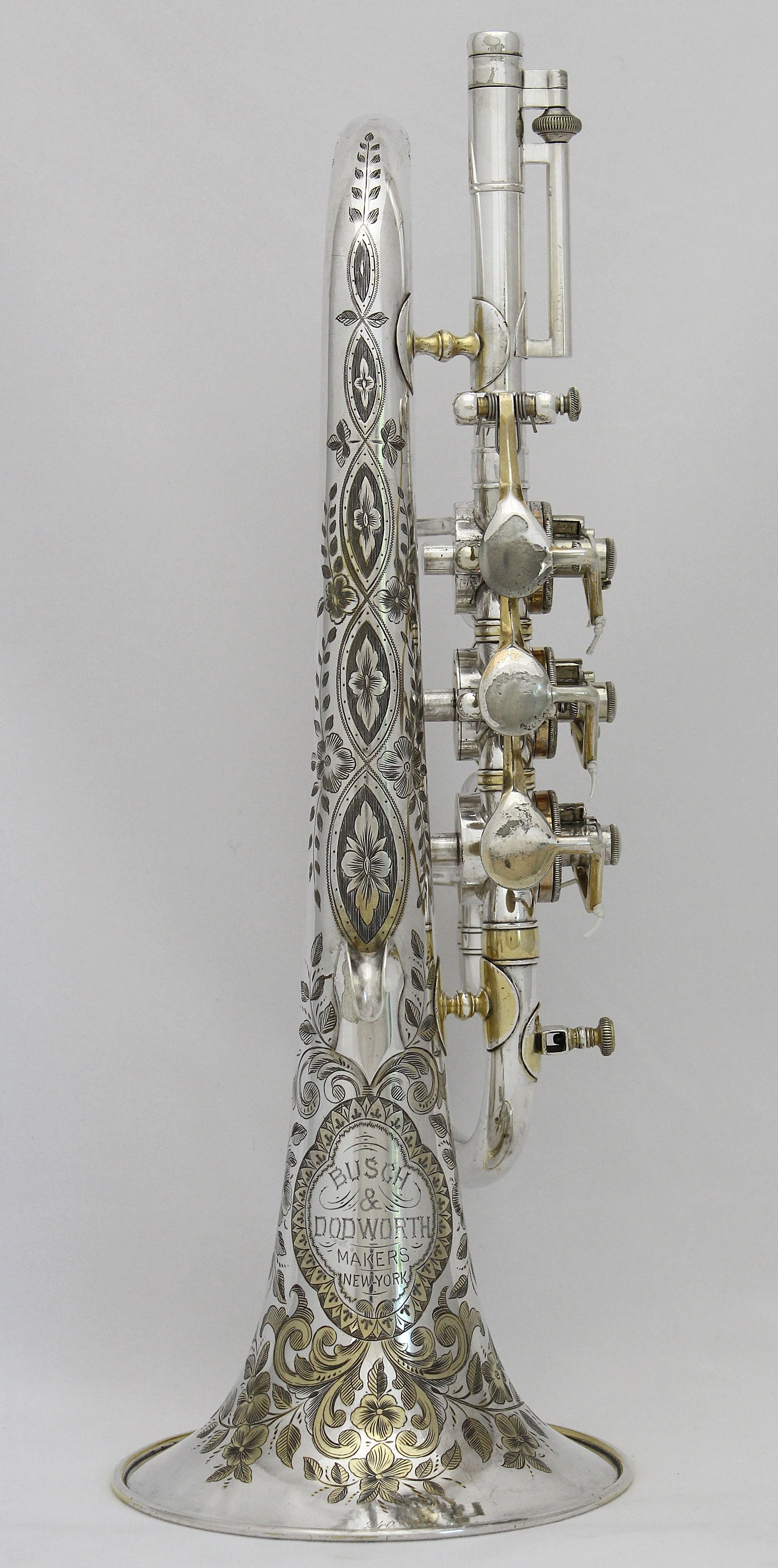Instruments Available from Harvey and Allen Dodworth From 1856 to 1885
This piano arrangement of "Amelia Polka", published in 1856, was among a small collection of piano arrangements published by Harvey Dodworth that I found back in the 1980s. It is certainly not a remarkable tune, but must have been among hundreds of dance pieces vying for popularity at the time. Harvey and his brother Allen Dodworth were important in the brass band and dance music scene in New York since the 1840s. I was very excited when I discovered that on the back cover is a list of some of the music available from Dodworth's but more importantly, the bottom third of this ad is an extensive list of brass instruments that were for sale from them (third image). I have examined over a dozen copies of this piece, including several of the same edition and many other Dodworth piano reductions from the time and this is the only copy of this list found.
Click on image for larger views.
This is the only list that I know of showing what brass instruments were available in a major US city at this early date. "Dodworth's Brass Band School" had been published three years earlier and is widely know among fans of early American brass bands. It illustrates instruments that were popular along with fingering charts and a few simple tunes to get your band started with but doesn't specifically mention what instruments that they were selling.
That said, it is not completely clear what instruments are being offered on this list either. When I first studied this list, I assumed that the more expensive, rotary valve instruments listed on the left were made in the US and the less expensive instruments listed on the right were imports. There are very few existing instruments with the Dodworth name on them and they seem to be from a decade or more later. I picture below an Eb cornet with bell over the shoulder that is quite obviously the same as those imported from Germany and sold by John Stratton in the 1860s through the 1880s and known to be inexpensive alternatives to the more expensive instruments made in New England. The only example that I know of from the 1850s with Dodworth’s name on it is a tenor horn with Berliner valves and bell over the shoulder in the First Brigade Band collection stamped: “J LECOCQ FROM PARIS / DODWORTH APPROVED / NEW YORK”. It is possible that this was one of the baritones with “Sax valve” listed on the right, but only those with Perinet valves are specified.
In the 1853 "...Brass Band School", Dodworth gives very high praise to instruments made by Isaac Fiske and specifically the five valve cornet made for him personally. Also, Fiske advertised basses in the unusual key of Ab in his 1861 catalog and many of the prices listed here are the same as in that same catalog. (E.G. Wright also listed basses in Ab in the early 1860s.) This doesn't prove anything, but it indicates some likelihood that Dodworth was selling Fiske's instruments in New York in the 1850s. Intriguingly, there is also listed here “CC Contra Bass” (tuba) and the only known early US made tuba in CC is one made by Thomas Paine in the 1850s.
The keyed bugles listed could be those made by Wright and/or Graves in Boston at that time. They could have been imports as well, but there are no known imports with more than 9 keys or pure silver keys known to us. I don't believe that there are any keyed bugles known to exist with the Dodworth name on them although I have restored several unsigned Eb keyed bugles that appear to have been made by Graves. Again, we can speculate and make reasonable connections, but there is no proof.
The list of valve instruments on the right may seem a bit confusing at first look, but all the forms mentioned are known to have been made in Europe (France and German countries) for the US market. "Ordinary Sax Valves" are what we call "Berliner Valves" today and there are a large number of such instruments both unsigned and signed by US sellers. The reason that they became known as "Sax Valves" is because the earliest Saxhorns imported into the US had Berliner valves and were popularized during the Distin Family’s tour in the US in 1849, playing instruments made by Adolphe Sax.
Brass instruments with Perinet valves were much less commonly used in the US in those years, but a number of examples, known to have been sold new, were made in Paris by Gautrot. I can't say for sure what the difference was between "Sax Horns" and "Ebor Cornos", but I believe that the latter were more cornet proportions compared to the valve bugle or flugelhorn proportions of the former. Today, this difference would be illustrated by the difference between a euphonium and Bb tenor or baritone horn, or even a valve trombone. As far as we know, the term “ebor (or eber) corno” was invented by the Dodworths and also used names such as “neo cor”, “trombacello”, “corino” and “cornetino”.
The "Trombocellos" all have double piston or what are commonly called "Vienna" valves today. These may have been the same as those made by Graves and Co. in the 1840s, but more likely the somewhat larger bore instruments that were being made in Austria and Germany by the mid-1850s. It is also interesting to note that there are no "post horns" being offered in this list, although they are still included, along with cornets and saxhorns, in "Dodworth's Brass Band School" in 1853. Other recent research has corroborated that the very small bore trumpets that were known as "post horns" in the US were being replaced by cornets and Saxhorns by the mid-1850s. The latest and best information on the subject is found in Sabine Klaus' "Trumpets and Other High Brass", volume 3.
In 1880, Allen Dodworth Jr. formed a partnership with Frederick Busch, a native of Markneukirchen, Saxony. Busch had been building brass instruments that incorporated imported parts in New York City since about 1869. Allen Dodworth Jr. was the son of Allen Dodworth, the brother of Harvey Dodworth, who had been active in New York’s music scene since his youth. Busch and Dodworth published a 27 page catalog, listing all sizes of brass instruments at competitive prices, with high quality engraved images of each. For example, Bb cornets ranged from $47 for their “New Besson Model” to $67 for the “Short Action, Acoustic, Busch’ Model”. The former was priced lower than C.G. Conn’s lowest priced Bb cornet and the latter was higher than Boston’s most expensive. The first three pages of that catalog are presented below. The introductory text tells of major investments in production capacity. Surviving instruments signed by F. Busch are fairly rare and this author knows of only one by Busch and Dodworth. We can’t know if this was a scheme to sell imported instruments or an overly optimistic business plan that faltered and failed at the start. Jon Patton reports that Busch left the new factory in February of 1881.
Pictured below is the only known example of an instrument marked “Busch and Dodworth”. It’s an Eb soprano cornet with bell proportions larger than more popular examples of the time, but smaller than the rotary valve bugles/saxhorns that were popular twenty years earlier. It appears to be custom built by Frederick Busch using a valve assembly from Boston. The style of rotary valve cornet was at least ten years out of vogue by 1880 and the catalog has no indication that instrument were available with rotary valves. It’s a bit of a show piece, with extensive, good quality engraving, silver plating and with gold plated trim. The plating is in very good condition, but where worn through, shows that tapered parts (bell and branch) are made of brass and all other parts of nickel silver. This was also a deluxe offering that was common in the 1860s, but very unusual after silver plating became much more common.
I welcome any insights or other comments about this document.










